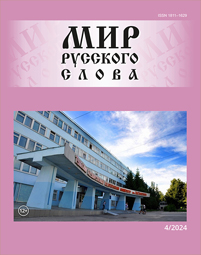Hair, headdress, cap: What is hidden behind them in the Russian language and culture
DOI:
https://doi.org/10.21638/spbu30.2024.402Abstract
The article considers a female headdress as one of the significant elements of the cultural code of the Russian nation and neighboring nations. The theoretical basis of the work is the idea of chronologically progressive dynamics of meanings assigned to the names of headdresses (mainly female) in the Russian language. From a historical point of view, the authors examine the emergence and further development of the custom of covering the head, a deep understanding of which allows one to establish most correctly a set of meanings attached to a female headdress as a symbolized entity and reflected in rituals, traditions, culture and language. Based on the conducted research, it seems possible to conclude that a woman’s headdress expresses social and spiritual-ideological semantics, being at the same time an indicator of a woman’s family status and a symbol of her piety. Since language is the basis of culture and national identity, its speakers in the process of communication appeal to culturally significant meanings that cannot always be interpreted unambiguously for various reasons. Thus, in the process of historical development of language and culture, which influence each other, some of the meanings lose their relevance and cease to be clearly understood by communicants. A similar fading of imagery and symbolism occurred with the words chepets and chepchik considered in the work, which are found in prose and poetic texts of Russian literature. The study found that in addition to being used in its direct meaning, the lexical units in question could be used in figurative meanings that are motivated by a set of symbolic meanings assigned to a female headdress in the past. The revealed figurative meanings of the lexemes in question are not always known to modern native speakers of the Russian language, which leads to an incomplete and even distorted understanding of literary texts of the 18th–19th centuries included in school and university philology curricula. The latter determines the relevance and practical expediency of the conducted research not only for linguoculturology, lexicology, phraseology, but also for philological didactics.
Downloads
References
Downloads
Published
How to Cite
Issue
Section
License
Articles of "The World of Russian Word" are open access distributed under the terms of the License Agreement with Saint Petersburg State University, which permits to the authors unrestricted distribution and self-archiving free of charge.




